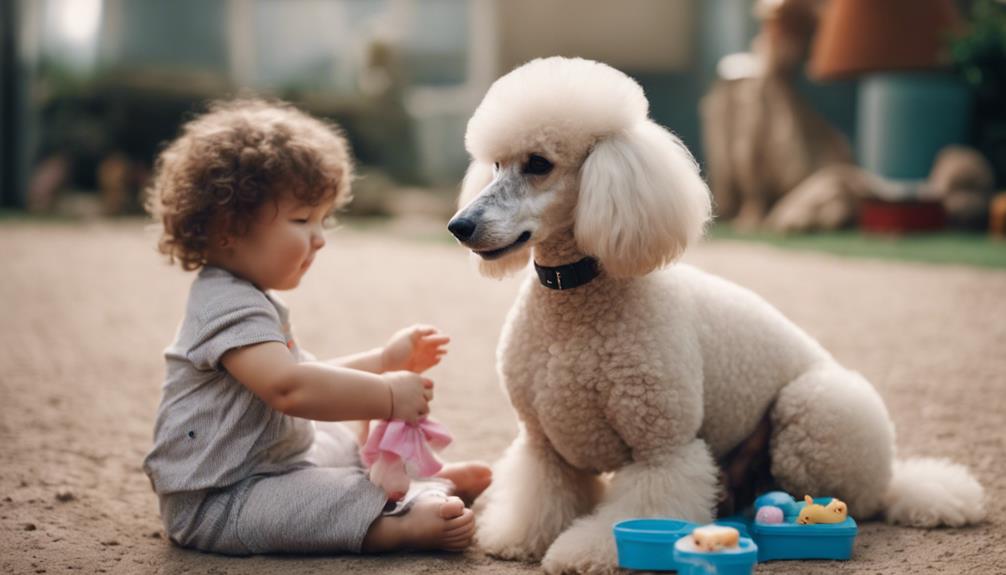Imagine your poodle navigating through unfamiliar terrain, encountering new scents and sounds like a curious explorer. As you embark on this journey of preparing your furry companion for a new baby or pet, there are crucial steps to take to ensure a harmonious transition. From acclimating to baby smells to setting clear boundaries, each action plays a significant role in your poodle's adjustment. But what about the moments when unexpected challenges arise, and how can you navigate those to ensure a smooth integration?
Key Takeaways
- Introduce poodle to baby smells gradually using positive reinforcement.
- Establish routines and training promptly for stability and good behavior.
- Familiarize poodle with baby sounds through exposure and positive associations.
- Use positive reinforcement, supervision, and mental stimulation to ensure a smooth transition for poodle.
Familiarize Poodle With Baby Smells
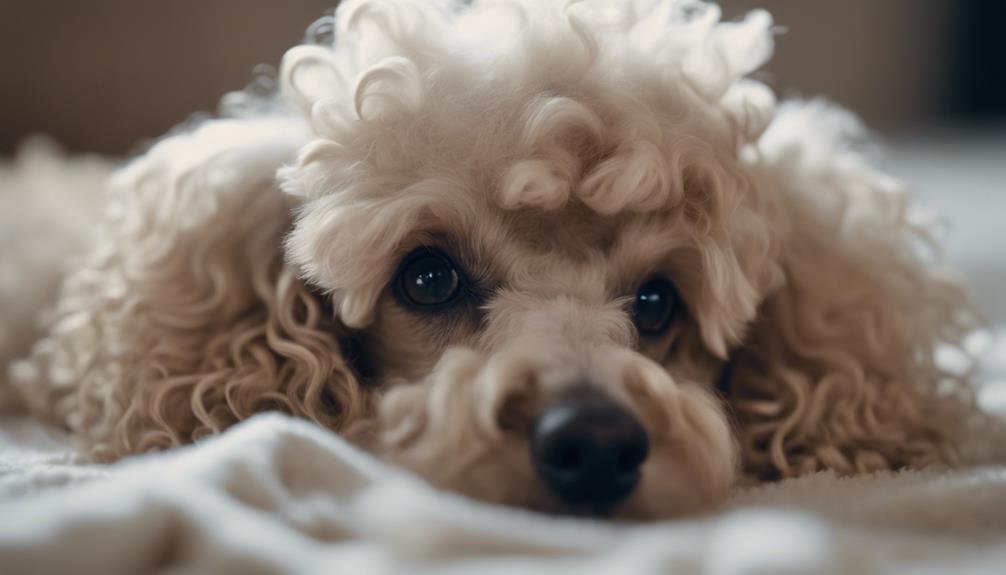
Start by introducing your poodle gradually to baby smells like lotion, powder, and diapers to prepare them for the arrival of a new baby or pet. Use positive reinforcement, such as treats, when your poodle shows interest in these scents. Allow your furry friend to sniff and investigate baby items under supervision. It's crucial to associate baby smells with calm and positive interactions to create a harmonious environment for both your poodle and the new addition to the family. Monitor your poodle's reactions closely when exposed to baby smells to gauge their comfort level. If your poodle seems anxious or uncomfortable, adjust your approach accordingly. By introducing baby smells in a controlled and positive manner, you are laying the foundation for a smooth transition when the new baby or pet arrives. Remember, patience and consistency are key in helping your poodle adapt to these new scents and changes in the household.
Establish New Routines Early On
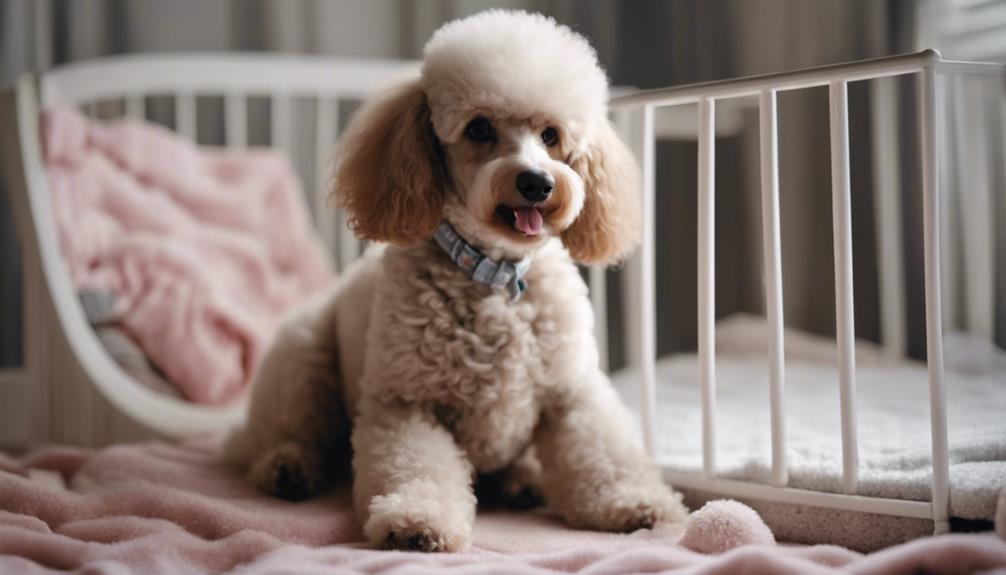
To help your poodle adjust smoothly to the upcoming changes, gradually introduce new routines aligned with the arrival of the new baby or pet. Establishing structured feeding and walking schedules can aid in preparing your poodle for the adjustments ahead. Here are some essential steps to consider:
- Set a Feeding Schedule: Establish regular mealtimes for your poodle to create predictability.
- Implement a Walking Schedule: Designate specific times for walks to help your poodle adapt to the new routine.
- Train Early: Start training your poodle on desired behaviors promptly to instill discipline and routine.
- Use Positive Reinforcement: Reward good behavior to reinforce positive habits and ease the adjustment process.
- Ensure Consistency: Maintain a consistent schedule to provide a sense of security and stability for your poodle.
Introduce Poodle to Baby Sounds
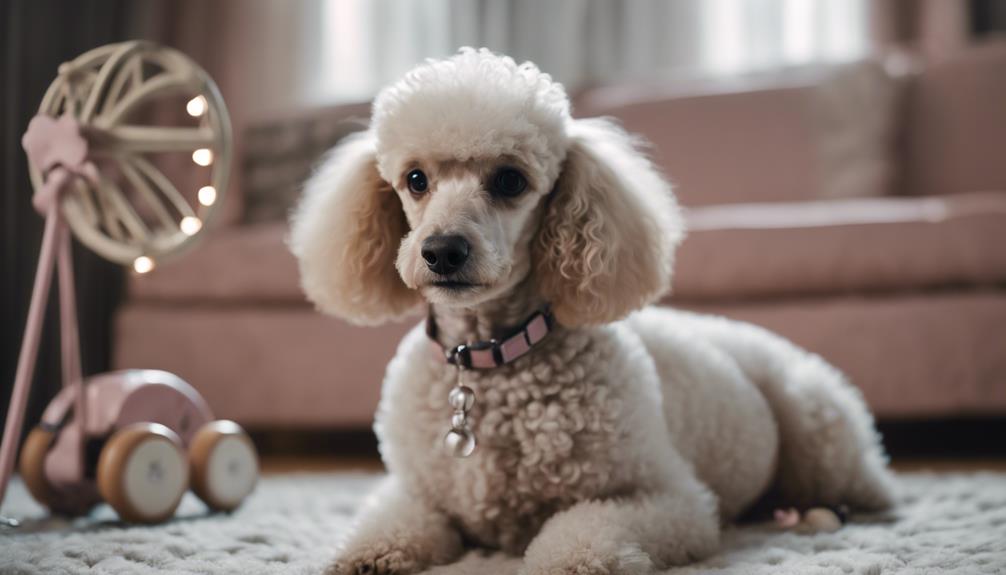
When preparing your Poodle for a new baby or pet, introducing them to baby sounds is crucial. Play recordings of baby noises around your Poodle to help them get accustomed to the sounds. Use positive reinforcement and monitor their reactions to ensure a smooth transition.
Baby Sound Exposure
Begin familiarizing your Poodle with the noises of a new baby by using recordings of various baby sounds.
- Start with low volume and gradually increase to help your Poodle adjust.
- Associate positive experiences like treats with baby sounds for a positive association.
- Expose your Poodle to a variety of baby sounds like crying, laughing, and babbling.
- Consistent exposure will aid in your Poodle becoming comfortable and desensitized to baby sounds.
Introducing your Poodle to baby sounds in a controlled and positive manner will help them acclimate to the new addition to the family. By creating a safe environment and associating these sounds with positive outcomes, you can ensure a smooth transition for both your Poodle and the new baby.
Positive Reinforcement Training
To acclimate your Poodle to baby sounds through positive reinforcement training, start by rewarding their calm behavior with treats when exposed to recorded baby sounds. This will help create a positive association between the sounds and rewards. Gradually increase the exposure to baby sounds while continuing to reward calm behavior. Additionally, you can pair the baby sounds with activities your Poodle enjoys to make the experience even more positive. Consistent positive reinforcement is key in helping your Poodle adjust to the new baby sounds more easily. Remember to be patient and supportive throughout this training process to ensure a smooth transition for your dog.
| Positive Reinforcement Training | Benefits |
|---|---|
| Rewards calm behavior with treats | Creates positive association |
| Gradually increase exposure to baby sounds | Helps adjustment process |
| Pair sounds with enjoyable activities | Makes experience positive |
| Consistent reinforcement | Smooth transition |
Supervised Interactions Introduction
To help your Poodle adapt smoothly to the presence of baby sounds, gradually expose them to recordings while offering positive reinforcement through treats to create a positive association. Introduce your dog to common baby sounds in a controlled environment to predict attention and treats. As your baby starts crawling, supervise interactions between your Poodle and the new sounds to ensure a calm introduction. Watch your dog's body language closely for signs of discomfort or curiosity. Provide reassurance and rewards for calm behavior during these interactions. It's essential to monitor your Poodle's reactions to baby sounds and gradually increase exposure to help them adjust comfortably.
Set Clear Boundaries and Rules
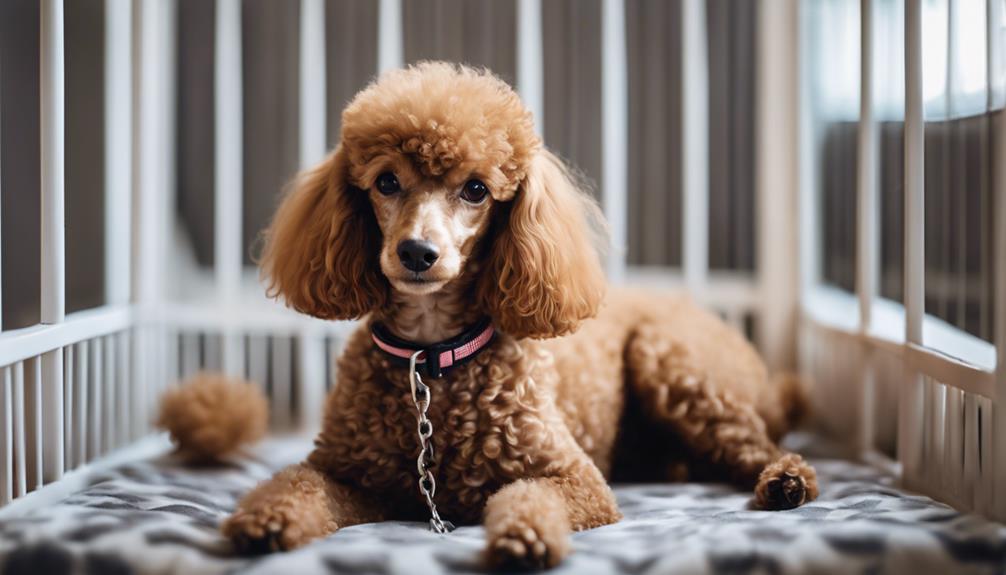
When preparing your poodle for a new baby or pet, setting clear boundaries and rules is essential. Establishing where your poodle can and cannot go in the house helps create a safe environment. Consistent enforcement and positive reinforcement will help your poodle understand expectations and ensure a harmonious household.
Establish Clear Boundaries
Establishing clear boundaries with your poodle is essential in preparing them for the arrival of a new baby or pet in your home. To ensure a smooth transition, follow these key steps:
- Clearly define areas where your poodle is allowed and not allowed to go.
- Create specific rules for interactions between your poodle and the new addition.
- Use positive reinforcement to enforce boundaries consistently.
- Set up physical barriers or designated spaces to help your poodle understand boundaries.
- Consistently enforce boundaries to maintain a safe and harmonious environment for all. By training your dog and teaching them the necessary boundaries with care and positive reinforcement, you set the stage for a successful integration of your new addition.
Consistent Enforcement Is Key
Consistently reinforcing clear boundaries and rules is essential for helping your poodle understand expectations and promoting a harmonious environment during the transition period with a new baby or pet. Set clear guidelines ahead of the new baby's arrival to give your poodle time to adjust. Use this time to get your dog used to the idea of limited access to certain areas or establish new routines. Keep interactions positive and calm, rewarding good behavior promptly. If needed, consider hiring a dog walker to ensure your poodle gets enough exercise and attention during this time. Consistent enforcement of rules will help your poodle feel secure and prepared for the changes ahead, fostering a smoother transition for everyone involved.
Positive Reinforcement Works
To effectively guide your poodle through the adjustments needed for a new baby or pet, employing positive reinforcement techniques to establish clear boundaries and rules is key. Positive reinforcement can help your poodle understand and follow new rules, ensuring a harmonious environment for everyone involved. Here are some key points to consider:
- Using treats and praise to reward desired behaviors sets a foundation for positive interactions.
- Consistency in applying positive reinforcement will help your poodle adjust to new rules around the baby or new pet.
- Clearly communicating expectations through positive reinforcement builds a harmonious relationship.
- Setting boundaries with positive reinforcement encourages good behavior and builds a safe environment for everyone.
Provide Mental Stimulation Activities
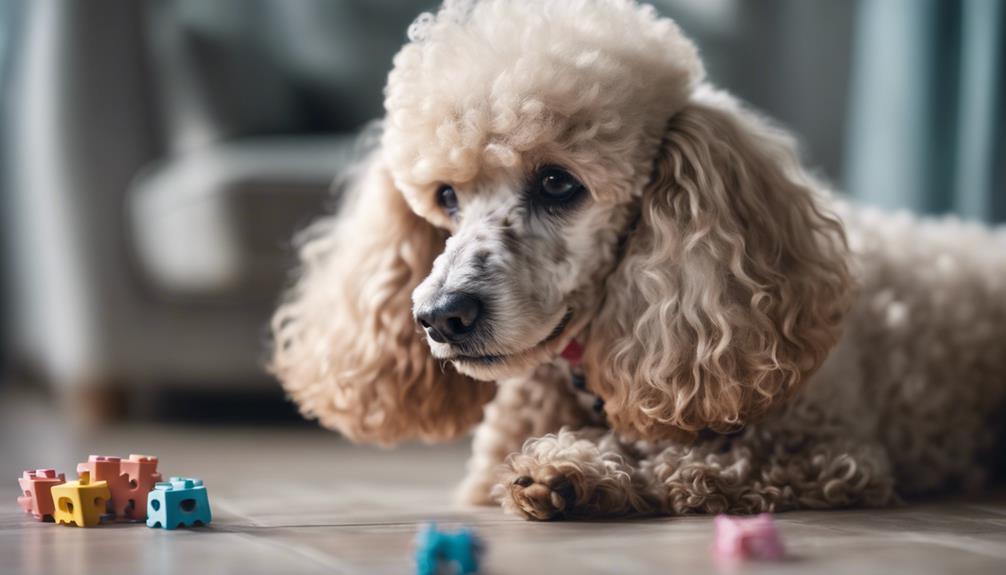
To keep your Poodle mentally sharp and engaged, incorporate puzzle toys that dispense treats into their daily routine. These toys not only provide mental stimulation but also offer a rewarding challenge for your furry friend. Rotating and introducing new puzzle toys regularly can prevent boredom and encourage mental agility. Additionally, integrating training sessions into your Poodle's schedule is a great way to challenge their cognitive skills and keep them mentally active. Interactive games like hide and seek can also be beneficial, offering both mental stimulation and bonding opportunities between you and your pet.
For a more advanced level of mental exercise, consider enrolling your Poodle in advanced training classes or canine enrichment programs. These activities can provide your Poodle with the necessary mental stimulation they need to stay alert and engaged. By incorporating these mental stimulation activities into your Poodle's routine, you are not only keeping them mentally fit but also strengthening your bond with your beloved pet.
Supervise Poodle-Pet Interactions
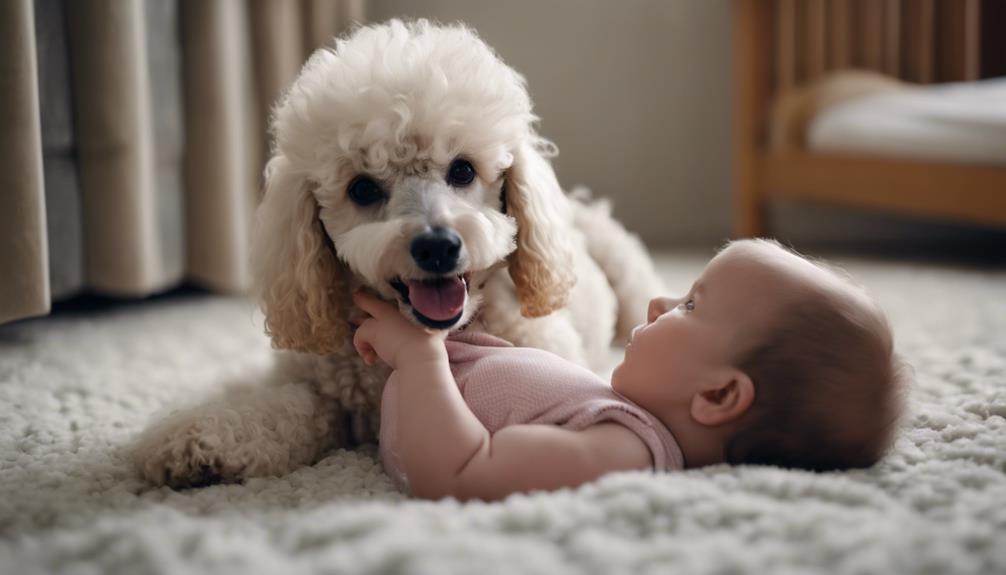
When introducing your Poodle to a new baby or pet, it's crucial to closely monitor their interactions. Set clear boundaries and provide safe spaces for both your Poodle and the new addition. Ensuring a controlled environment will help foster positive relationships and prevent any potential issues.
Monitor Playtime Closely
Ensure you carefully supervise all playtime interactions between your Poodle and the new baby or pet to promote a safe and positive environment for bonding. Monitoring their body language and behavior during play is crucial to ensure a harmonious relationship. Here are some key points to consider:
- Monitor body language: Watch for signs of stress or discomfort.
- Intervene if necessary: Prevent rough or intense play to avoid accidents.
- Encourage gentle play: Promote positive interactions between your Poodle and the new addition.
- Teach appropriate behavior: Utilize play sessions to establish boundaries and good behavior.
- Build a harmonious relationship: Use playtime as an opportunity for bonding and learning.
Set Clear Boundaries
Supervise all interactions between your Poodle and the new baby or pet closely to establish clear boundaries and ensure a safe and positive environment for bonding. Start teaching your Poodle the rules of engagement with the new family member from the beginning. Help your dog understand what behavior is acceptable and introduce that restriction gently but firmly. Monitor body language closely during interactions to pick up on any signs of discomfort or aggression. It's crucial to intervene immediately if needed and provide positive reinforcement for good behavior. Below is a table to guide you in understanding your Poodle's behavior cues:
| Positive Behavior | Negative Behavior |
|---|---|
| Tail wagging and relaxed body | Growling or raised fur |
| Playful barks | Stiff posture |
| Gentle licking | Avoidance or hiding |
| Ears relaxed | Snapping or nipping |
Provide Safe Spaces
To ensure a harmonious introduction between your Poodle and the new baby or pet, creating designated safe spaces is essential for managing interactions and fostering a positive environment.
- Supervise all interactions: Watch over your Poodle and the new baby or pet at all times.
- Use baby gates or pet barriers: Set up physical boundaries to control interactions.
- Provide positive reinforcement: Reward good behavior around the new baby or pet.
- Monitor body language: Pay attention to your Poodle's signals and reactions.
- Understand comfort level: Respect your Poodle's comfort level during interactions.
Teach Poodle New Training Commands
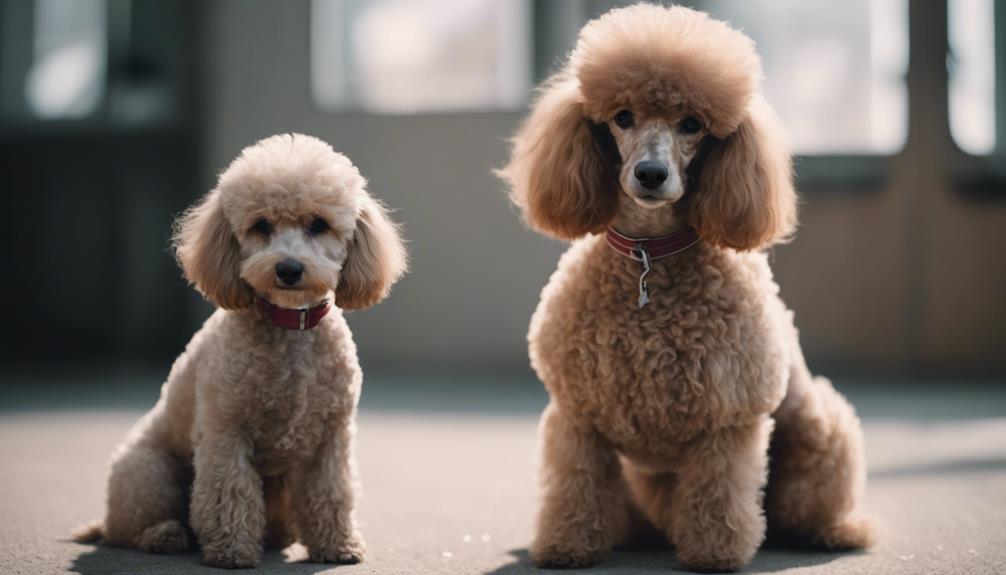
When teaching your poodle new training commands, it is essential to start with basic obedience skills like sit, stay, and come. As you prepare your furry companion for the arrival of a new family member, such as a baby, incorporating specific training commands becomes crucial. Introduce commands like 'leave it' or 'go to your place' to manage interactions with the new sounds associated with a baby. Positive reinforcement plays a vital role in this process; use delicious treats and praise to encourage learning effectively. Consistency is key; practice these commands in various environments to ensure your poodle can follow instructions in different situations. If needed, consider consulting a dog trainer to assist in teaching advanced commands tailored to your specific needs. By investing time and effort into training your poodle, you are not only preparing them for the changes ahead but also strengthening the bond between you and your loyal companion.
Prepare Poodle for Lifestyle Changes
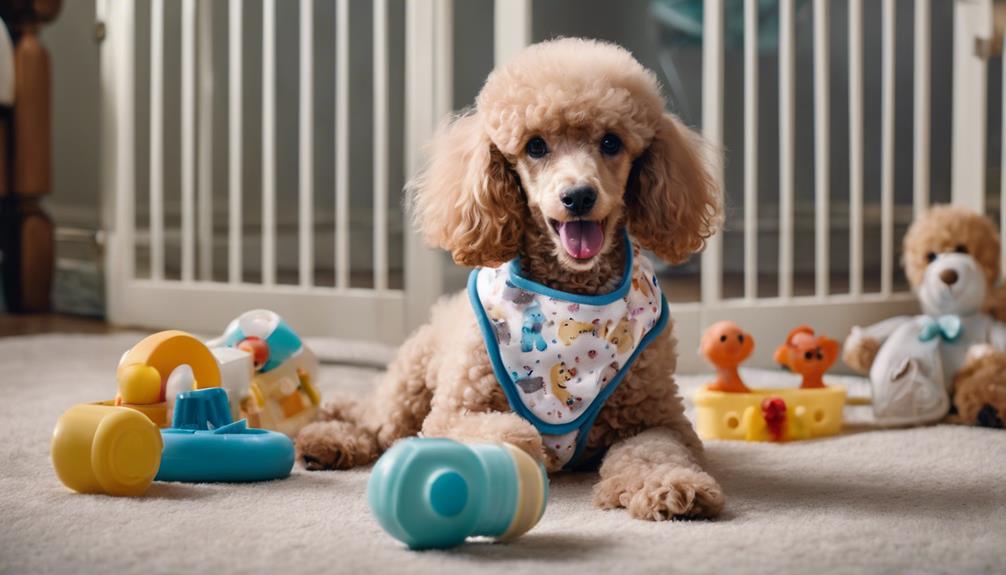
To help your poodle adapt smoothly to upcoming lifestyle changes, gradually introduce them to new baby gear and furniture adjustments within your home environment. This will familiarize your pet with the changing surroundings and help them feel more comfortable during the transition. Here are some essential steps to prepare your poodle for the changes ahead:
- Introduce baby gear changes: Allow your poodle to sniff and explore new baby items to reduce novelty.
- Practice walking with stroller: Get your poodle used to walking alongside a stroller to adjust to potential routine changes.
- Establish new routines: Start implementing variations in your daily schedules early to help your poodle adapt.
- Consider obedience classes: Enroll your poodle in obedience classes or daycare to prepare them for the new addition.
- Maintain a positive relationship: Ensure consistent training and interactions to foster a smooth transition and a positive relationship with the upcoming changes.
Create Safe Spaces for Poodle
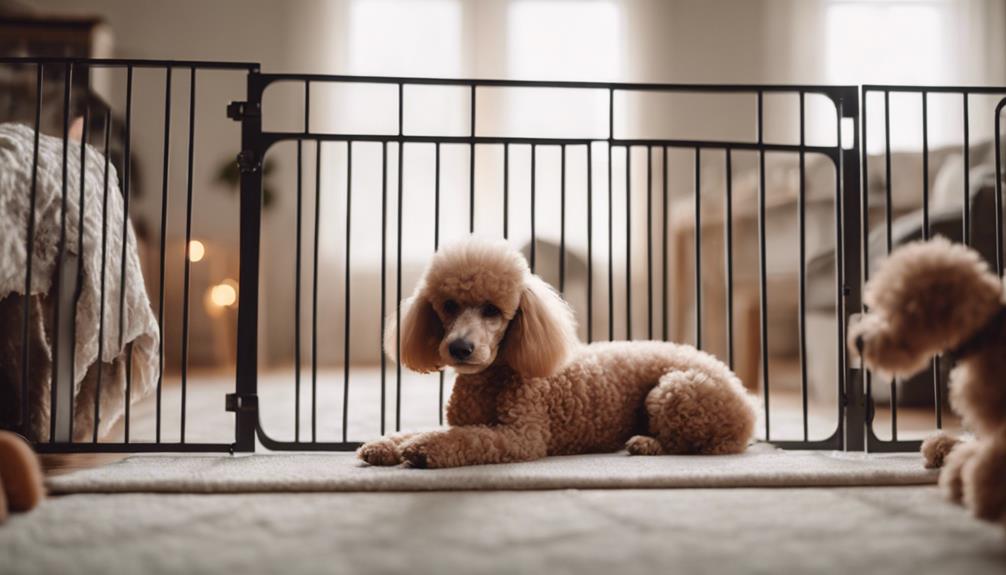
Consider creating designated safe spaces for your Poodle to retreat to, ensuring they have a comfortable and secure area within your home. Utilize dog gates or playpens to establish boundaries in a specific area where your Poodle can feel protected. Provide a cozy and comfortable crate with positive associations, such as favorite toys, treats, and blankets, to make it a welcoming space for your furry friend. By incorporating these familiar items, you can help reduce your Poodle's stress and anxiety when they need some alone time. Make sure the safe space is easily accessible and free from loud noises or disturbances, promoting a sense of security for your pet. Creating a safe haven for your Poodle will not only benefit them but also contribute to a harmonious environment as you introduce changes like a new baby or pet into your home.
Ensure Positive Poodle-Baby Encounters
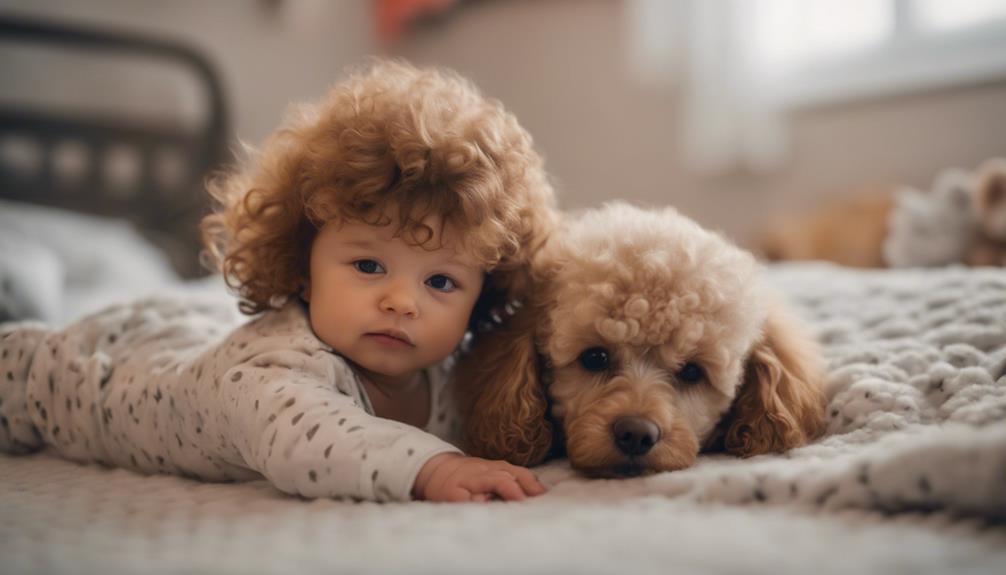
To ensure a smooth introduction between your poodle and a new baby, focus on facilitating positive interactions and fostering a harmonious relationship from the start.
- Supervise: Always supervise interactions between your poodle and the baby to ensure safety and positive experiences.
- Respect Space: Teach your poodle to respect the baby's space and signals for a harmonious relationship.
- Positive Associations: Create positive associations between your poodle and the baby through treats and praise.
- Gentle Play: Encourage gentle interactions and play under close supervision to promote a healthy bond.
- Clear Boundaries: Set clear boundaries and rules for interactions to establish a safe environment for both the poodle and the new baby.
Frequently Asked Questions
Is It Better to Get a Dog Before or After Having a Baby?
It's essential to consider the timing of adding a dog to your family regarding family planning and pet dynamics. Assess behavioral training and bonding strategies, evaluating how the pet will fit into your family before or after having a baby.
How Do You Introduce a Poodle to a Baby?
When introducing a Poodle to a baby, allow calm, positive interactions with treats and praise. Respect your Poodle's boundaries, provide space, and supervise closely for a safe and harmonious blend of poodle behavior and family dynamics.
How Long Does It Take for a Dog to Adjust to a New Baby?
Adjusting to a new baby can take your poodle 3 to 6 months. Factors like age, temperament, and prior kid exposure matter. Watch closely for behavior changes. Positive reinforcement, routines, and gradual introductions can ease the transition.
How Do You Train a Dog to Be Around a New Baby?
To train a dog around a new baby, focus on dog training techniques like positive reinforcement, setting boundaries, and socialization skills. Babyproof your home, supervise interactions, and consider your Poodle's temperament for a smooth adjustment process.
Conclusion
As you prepare your poodle for the arrival of a new baby or pet, remember that patience and consistency are key. Just like a well-tended garden grows beautiful flowers, nurturing your poodle through this transition will lead to a harmonious family dynamic. By sowing the seeds of love, training, and understanding, you are cultivating a strong bond that will blossom into a lasting relationship filled with joy and companionship. Trust the process and watch your family flourish together.
